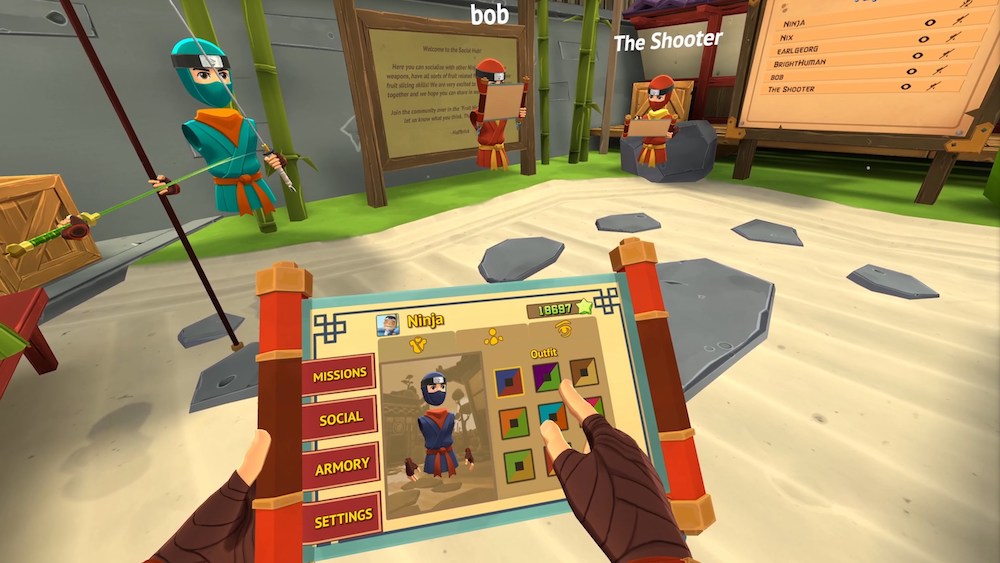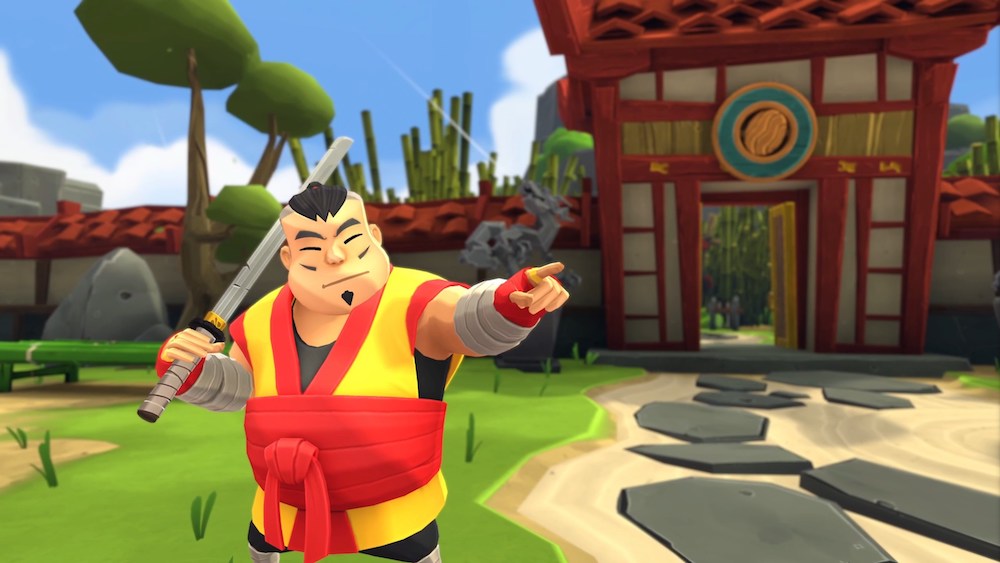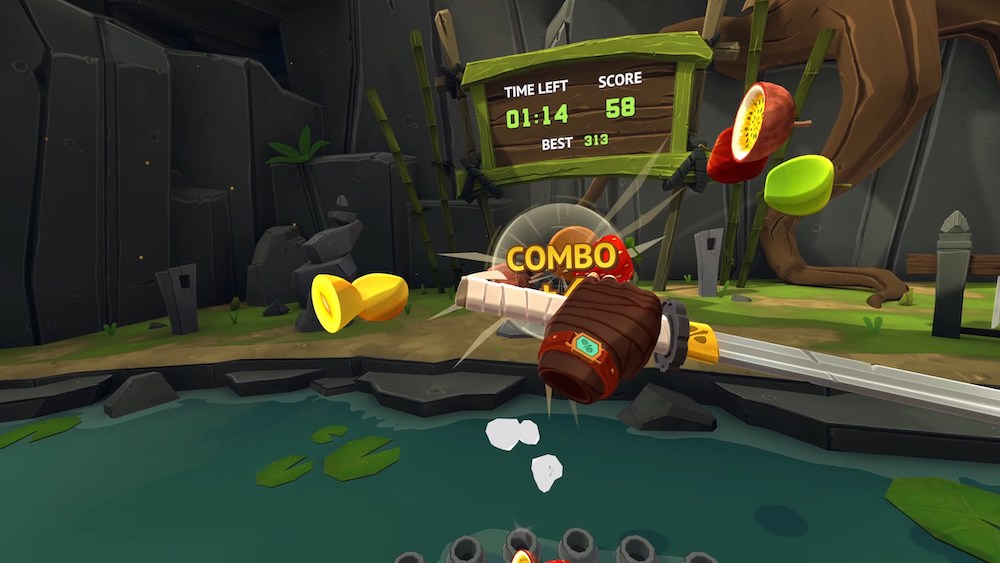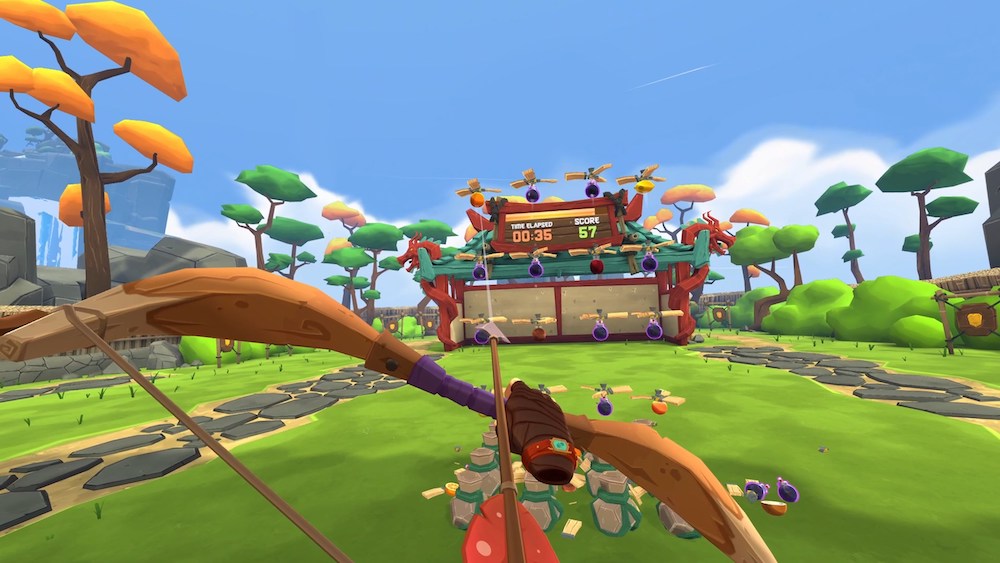Obsessed with making games that people will remember for a lifetime, half brick decided to convert their hit title, Fruit Ninja, into a VR game. It was a natural evolution – people apparently really enjoy slicing fruit and swinging swords. After that success, they created Fruit Ninja VR 2 – adding more features and exploration to the game.
“Making a game for VR is very, very different,” said Liam Potter, one of the lead gameplay programmers on Fruit Ninja VR 2. “There are a lot of things you need to take into account that you just don’t for console or mobile.”
With that in mind, let’s dive into those challenges and see what Liam advises.
Show players the play space early
In a VR experience, it’s incredibly difficult to make sure that players are looking where you want. Gamers notoriously fail to look up in regular games, but in VR, it’s even more of a problem. Players can look anywhere at any time. So getting them to focus on the correct place is tricky.
“If we don’t direct the player properly, they could look at it from the wrong angle or completely miss something that’s outside their field of view,” Liam said. “So we needed to let the player see the play space before anything happens. If they know where things will happen, they’re more likely actually to see it.”
So prepare your players. Show them their local surroundings, before dumping them into the action. Otherwise, they might easily get lost.
Use audio clues to grab their attention
Another method to make sure that players are looking the right way is to remember that VR isn’t just a visual experience. You can use directional sound, too.
“Audio is another major strength of VR,” Liam said. “It’s a very useful tool for directing the player’s attention. If you hear something outside your field of view, you know where it’s coming from and naturally turn your head. It’s very distinct.”
Enemy footsteps, powerups, item drops, or even oncoming danger needs these audio clues – otherwise, the player is going to miss them. Think about how frustrating it would be if you were playing a shooter game in VR and could never tell where the enemies were. So maybe in that situation, the player hears the sniper’s gun cock, before they fire.
Strip back your user interface
In VR, you can’t really have a heads-up display. It’s strange and disorienting. Instead, you’ll need to come up with other workarounds to show that same key information – in a much more immersive and natural way.
“This really changes based on what you want people to experience,” said Liam. “But if you want an immersive experience, you can’t have a HUD. It’d be floating in the corner, and you’d have to only move your eyes if you wanted to look at it. People just don’t like doing that.”
On the first Fruit Ninja VR, this wasn’t too much of an issue – there wasn’t much need for a HUD anyway. But for the sequel – where the player can explore – it presented a key challenge for Halfbrick to overcome.

“We wanted to make it more immersive,” Liam said. “So we moved all that HUD onto a physical pad – a ninja scroll. You pull it out, and it’s like a real-life tablet. You press buttons with your other hand and interact with it in a much more natural way.”
As Liam mentioned, every game is different. And you might need to come up with clever ways to show specific pieces of information. Guns can have their ammo count on the model itself. Health could be written on the back of your hand. Settings and meta features might be on a watch. The key is making it something that feels natural to the player.
“But remember,” Liam added. “The player can’t see the controller. You can’t rely on them to remember simple button prompts. It needs to be really simple and intuitive.”
Play with immersion and interaction
One of the core mechanics of a VR game is being able to interact with the world around you. It’s such a fundamental mechanic that it feels strange if your game doesn’t include it.
“Mobile’s strength is being able to pull the game out instantly and start playing,” Liam said. “VR’s strength is immersion. So you should play with that idea. You might as well attempt to incorporate more immersive things into your game if you can. The more you are playing to the strengths of the platform, the better.”
And immersion leads to interaction. Being able to reach out and feel like you’re touching a physical object is key to VR experiences.
“But don’t mold your interactions around your design. Mold your design around the interactions,” Liam said. “Look at what’s fun – you can pick things up, throw them, look at them. Those might not change your design, but it’ll improve the immersion.”
Cater to all audiences
VR is a huge expansive arena, and there are plenty of gladiators that want to step in and try their hand at it. But the motivations of those players may vary wildly.
“One of the key motivations is exploration,” Liam said. “Some players want to really explore the map and travel around. But others want to jump right in and explode some fruit for a while.”
It’s important to cater to each of these audiences. Halfbrick navigated this challenge in more ways than one by adding a fast-travel system to their ninja scroll.
“We initially didn’t have a fast travel system,” Liam said. “But some players don’t want to walk around; they want to get into the action straight away. Why exclude those people? Now, once they’ve found an area, you can get out your scroll and boop – you’re there.”
Make sure they can physically do it
It’s really important to make sure that you think about the physicality of the game itself. In VR, people are actually moving around. There are actually three parts to this.
1. Be wary of making people feel sick
“Realistically, VR is a demanding space,” Liam said. “You can get tired and even sick while playing VR. And people’s comfort levels are very different.”
Halfbrick found this was particularly true for movement mechanics, where there are three usual ways to move around:
- Blink. The view disappears, and the user teleports to another location.
- dash The view surges forward and feels like it’s moving, but in a set amount for each button push.
- Smooth. The player moves around like a typical first-person game.

“Make sure you give people the option to change how the movement feels,” Liam said. “We initially didn’t have those movement controls. And we really saw that retention in the onboarding phase wasn’t doing too great. We were using analytics and saw that a decent amount of people were only using dash. But if you can’t use that mode – and that’s the only mode you think is available – you’re cutting those people off.”
Halfbrick realized that some people were just feeling sick and taking the headset off before they even really started. So they ended up showing people the movement options before the rest of the tutorial.
2. Make sure your actions don’t overlap
It’s not just moving around the map that you need to be careful with. It’s how people move their arms, too.
“When you’re in VR, you might want the player to go really crazy,” Liam said. “But they need to be able to physically do it. We could throw fifty fruits at the player, but can they physically slice those? How do we design the waves to be satisfying?”
Halfbrick needed to be constantly aware of where the player’s arm was and in what position it would end up in.

“Where is the player’s arm? If they slide across, you don’t want them to need to make the exact same action again,” Liam said. “Generally, we design our waves so that it’s fun to do combos. You want to have the player slice like seven fruit in one swing, without getting all tangled up.”
3. Consider the player’s body size
Another aspect is the player’s physical height and the length of their arms. This can affect how you design your levels.
“In normal gameplay, it didn’t really matter how tall or long someone’s arms were,” Liam said. “People can just step backwards or forward. But with archery, we had a real problem with people’s heights. If you were too short, you’d have to hold the bow up in the air to hit the angle.”
In the end, Halfbrick had to normalize the height during this section of the game – to make sure that everyone was on a level playing field.
“We also think about how we designed the space,” Liam said. “How long should the blade be? How long is the general person’s arm? That’s important, because you don’t want to be slicing the fruit at the base or the tip – and you don’t want it coming too close to your face.”
This affected how far away the fruit should be when it was flinging past the player. It had to be at that perfect distance that felt natural.
Be aware of what platform you’re using
While VR often feels like its own platform, it actually varies quite significantly between devices.
“Are you going to be on PC or console? Or are you using a standalone platform, like the Quest, where it’s not connected to anything?” Liam said. “If it’s the latter, you have to recognize that it’s essentially a mobile device. Powerful, sure. But it still has limitations.”
And those limitations might seriously affect how people feel while they’re playing your game.

“Bad performance might not kill a game on PC, but if your game runs poorly in VR, you’ll make people physically ill,” Liam said. “Imagine every time you walk through the door, and you have a frame drop. You might not notice that, but your brain will. And you’ll start to feel ill. Even small drops.”
So test thoroughly to make sure that you’re not getting any delays or lag. If there’s just a little bit, your players might stop playing.
Track how people interact with objects
“Analytics are great for every game, but those interaction analytics are super important for VR,” Liam said. “Being able to track what they’re enaging with and how long they’re interacting with it – it’s important. Once you have that info, you can ask the questions like: Are they missing anything? Is there anything they’re avoiding? Do they stick to just one interaction?”
So it isn’t just about metrics like retention. There’s far more to look at when it comes to VR.
“There are lots of metrics that can give you important insights. But what people are doing with their hands is a hugely important aspect of VR, “Liam added.
Start your own VR journey
Halfbrick uses their own in-house analytics to track what’s happening in their game. Sadly, you can’t use that. But if you want to get set up quickly and start developing VR games yourself, you can use our free analytics platform.
